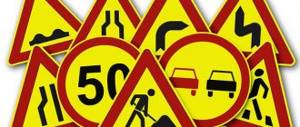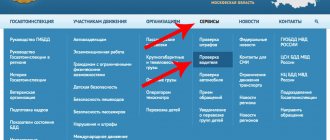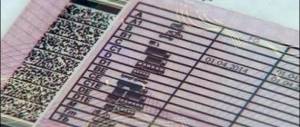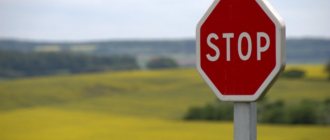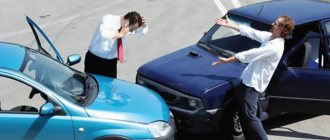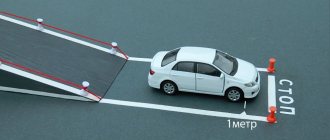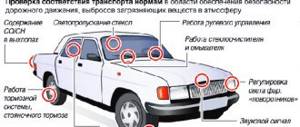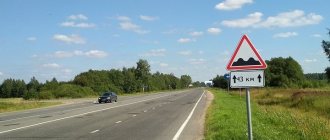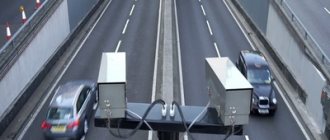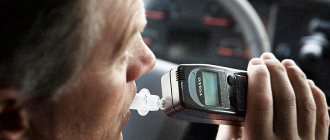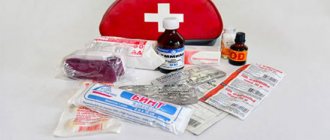- October 26, 2019
- Automobile law
- Karina Perevalova
According to traffic regulations, a U-turn is one of the most dangerous maneuvers. If we analyze the statistical data, we can conclude that very often road traffic accidents occur when the rules are not followed. At the same time, not all drivers remember where it is possible to turn around, and in what areas it is strictly prohibited. Below we describe which signs and markings allow you to perform the maneuver. In addition, it is indicated in which places you can make a U-turn and how to do it as safely as possible.
Signs and markings
To make a U-turn on the road, you need to know which symbols allow it.
Signs:
- "A place to turn around." The symbol is depicted on a blue background; it is intuitively clear to every driver. If there is such a sign, according to traffic rules, you can make a U-turn without any fear. However, it is important to remember that this symbol prohibits turning left.
- "Turnaround area." A sign similar to the one described above. Their difference is that this symbol indicates the length of the turn zone, for example, 15 m. When performing a maneuver at the same time, you must give way to the vehicle located on the right side.
The presence of a road sign allowing a U-turn is the most favorable situation for the driver. However, you also need to know the symbols prohibiting the maneuver.
These include the following signs:
- "U-turn is prohibited." This symbol does not allow maneuvering at an intersection. However, left turns are allowed.
- "Go straight ahead." The sign instructs you to go only in the indicated direction. It prohibits not only U-turns, but also left and right turns.
- "Move to the right." Accordingly, you need to drive only in the indicated direction.
- "Move straight and to the right."
- "One way road." A U-turn on such a roadway inevitably leads to entering the lane intended for the oncoming direction.
- "Driving directions along the lanes." These signs may or may not allow you to make a U-turn.
Regarding the markup. In her case, everything is much simpler. According to traffic rules, a U-turn cannot be made if it requires crossing a single or double solid line. Intermittent markings allow the maneuver.
Conditions for prohibiting a turn: provisions of clause 8.11 of the traffic rules
Moving along a route, a person, first of all, is guided by a special network of road signs that indicate that the maneuver is prohibited. But the provisions enshrined in law also initially stated several sections of highways where under no circumstances should U-turns be allowed in order to avoid an emergency.
Stops
Public transport stop areas are considered unacceptable for U-turns due to large crowds of people. The trajectory of a car can be sharply shifted at any moment - this endangers people waiting for a bus or tram. The rules stipulate where you can make a U-turn.
It is permissible throughout the entire distance beyond 15 m from stop signs or special yellow markings.
Railroad crossings
The danger of turning combinations at railway crossings is due to the narrowness of the roadway characteristic of these objects. To perform this technique, you need to reverse, and you must concentrate on timing due to the movement of the trains. Where is a U-turn prohibited? In the area between barriers or special car signs.
Pedestrian crossings
In the process of making a U-turn at a zebra crossing, a real danger is created for the lives of pedestrians who have the right of way when crossing the street. If the markings are not visible on the road, try to follow the signs on opposite sides.
A turn according to established standards can be performed before or after a zebra crossing.
Bridges, overpasses, overpasses
These structures do not have enough space to attempt a U-turn from the side of the road, and do not accommodate even small vehicles to make a 180-degree turn. If you do not calculate the trajectory to the minimum values, you can simply crash into the side restrictions of buildings or fall from a height.
Tunnels
The same limited space, coupled with insufficient lighting, does not provide the full possibility of making a U-turn outside the intersection.
Places with low visibility
It is impossible to react in time to the movement of oncoming vehicles, having insufficient visibility within a radius of 100 meters.
If there are signs
To make it clear to the driver where he should not attempt to make a U-turn, the regulations include a special “No U-turn” sign numbered 3.19. The sign shows a curved black arrow within a red circle with a line through it. It is usually located in front of the object where it is forbidden to cross the roadway, so as not to create a danger for cars and pedestrians. But in other directions, the reversal combination can be performed freely. The effect of 3.19 does not apply to vehicles that are subject to following the route.
If it is yellow, then it was installed only temporarily.
Sometimes 3.19 is placed together with the 8.1.1 indicator. This means that the prohibition on a U-turn applies only to the distance specified in the sign. And the indication of the turns “Right turn is prohibited” and “Left turn is prohibited” indicates that it is not advisable to make a U-turn along the indicated path if there are other prohibiting circumstances.
Also prescribing a ban on a reversal combination to the left side include signs with numbers:
- 4.1.4;
- 4.1.1;
- 4.1.2;
- 5.5;
- 5.15.1;
- 5.15.2.
If there are markings
It’s even easier to navigate using the paved markings than using car signs. There are several options when you do not have the right to maneuver:
- if a single solid line is drawn;
- if a double continuous one is applied;
- if one of two lines is broken, you cannot turn to a solid one;
- If the markings indicate the direction of flow along the lanes, then you cannot turn left from the far left side.
On the motorway
The traffic rules also stipulate that it is inadmissible for cars to make a U-turn on the highway or on the road. To perform the required maneuvering, you can use the areas marked with the instructions “Place for a turn” and “Area for a turn.” But using technological gaps for this is strictly prohibited.
U-turn at an intersection
The basic rule for its implementation is to quickly and correctly determine a safe trajectory. According to traffic rules, a U-turn can only be made from the extreme left position. The exception is cases when the width of the roadway is small or the vehicle has large dimensions. But in this situation, it is important to make sure in advance that the maneuver being performed is safe for other road users.
Conditions that must be observed when turning at an intersection:
- It is unacceptable to enter lanes intended for vehicles moving in the opposite direction.
- You need to get into your lane.
- It is unacceptable to drive beyond the boundaries of the intersection.
- It is prohibited to cross a double solid line.
- It is necessary to give way to all vehicles that have the right of way. Even if it takes a long time.
The maneuver can be carried out along two trajectories:
- Near. In this case, the roadway must be wide enough. It is also important to assess in advance the likelihood of driving not only onto a solid marking line and a pedestrian crossing (if there is one), but also onto a curb. Correcting the trajectory of movement by engaging reverse gear at an intersection is prohibited.
- Far. This trajectory is appropriate if the road is narrow or, for example, the vehicle is long. For example, turning a truck along a near path is impossible, therefore, you need to move along a far path. The same situation can arise if road work is underway at the intersection.
It is important to remember one rule - if there is a dividing strip, the turn is always carried out along the far path. Ignoring this condition leads to the fact that the vehicle, albeit briefly, will end up in the oncoming lane. The consequence of this violation may be a fine or deprivation of a driver's license.
Types of U-turns by car
Types of turns performed in a car or other transport can be divided according to the characteristics of the trajectory:
- The far one is selected if it is not possible to change the direction of movement in a small semicircle. This is sometimes hampered by the lack of space and the impressive dimensions of the machine. Then you should drive a little forward and turn in such a way as to leave yourself room to align the car and accurately enter your lane.
- The closest one is more profitable if there is enough space on the site, because this way it will be possible to complete the action faster. The turn should begin from the beginning of the intersection of paths at the edge of the line separating the oncoming row. It is necessary to avoid contact with the curb and driving into a pedestrian crossing or continuous markings.
Turning at an intersection along a long trajectory
U-turn at a traffic light
Sometimes it is advantageous to make a U-turn at a traffic light, because it makes it easier to control the car from other directions. You can carry out an action correctly if you break it down into stages:
- press against the line separating the flow of oncoming traffic;
- turn on the turn signal in advance and drive to the middle of the intersection at the permission signal;
- let oncoming cars pass, if there are any;
- complete the maneuver even if the traffic light is red (traffic regulations allow this).
Turn left and turn around outside the intersection
A left turn, as well as a U-turn outside an intersection, is carried out in compliance with the requirements of clause 8.8. Traffic regulations:
- it is necessary to give way to oncoming traffic and trams traveling in the same direction;
- start the action from the extreme left position;
- if the road in this place is not wide enough, it is allowed to perform it on the right side of the roadway or shoulder.
The last rule allows you to do without engaging reverse, which makes turning easier.
How to find a place to turn around
You can find a place to safely make a U-turn using the following criteria:
- the road must have a lane for oncoming traffic, that is, not one-way;
- it’s good if it is wide enough or narrow, but the site has an entrance/exit to the adjacent territory;
- the absence of signs prohibiting the action and continuous markings is mandatory;
- you need good visibility of the road in all directions.
The selected location should not contain the objects listed in clause 8.11 of the traffic rules.
Watch this video on how to properly turn around at an intersection:
How to make a U-turn on a busy road
To perform action during heavy traffic, you can use the following techniques:
- Moving to the adjacent territory. This is the entrance to a gas station, a parking lot, and a courtyard formed by buildings. It's best to go there, turn around right there, if the adjacent area is on the right. Another option is to use the pad and reverse to change direction when he is on the left.
- Detour around the problem area through several intersections. It turns out to be quite a long distance. But with rectangular blocks, turning right at the first two intersections and left at the fourth, you can change the direction of movement relative to the original one.
T-junction
At a T-junction, there can be three scenarios when making a U-turn:
- The car is driving along the main road. In this case, he yields to oncoming cars.
- The car is located on a secondary road. When performing this action, you should give way to vehicles traveling in the opposite direction and approaching from the right.
- The roads are equal. The rule of interference on the right side also works here (they give way to it).
With dividing strip
At an intersection with a median, the main thing when performing a maneuver is not to follow the oncoming traffic. And to do this, in most cases you need to drive along a long trajectory. The vehicle will be in the oncoming lane only for the sake of crossing it, that is, the maneuver will be performed correctly.
Driving along a short trajectory will lead to the fact that the turning car will follow a short segment along the oncoming lane. And this is a violation.
With tram tracks
On a road where there are tram tracks, the maneuver is regulated by the second paragraph of clause 8.5 of the traffic rules:
If there are tram tracks in the same direction on the left, located at the same level as the roadway, a left turn and a U-turn must be made from them, unless signs 5.15.1 or 5.15.2 or markings 1.18 prescribe a different movement order. In this case, there should be no interference with the tram.
It is carried out in compliance with the following requirements:
- a rail vehicle must be allowed through if there is no traffic light on the site and the roads are of equal importance;
- the same is done if there is one, and the signals of the light device are intended for both types of transport;
- if there is a separate traffic light section for the tram, the main one for it is red, and for cars it is green, it is also better to let the rail vehicle through, since the permissive signal on the switch may light up at any time;
- If there is no traffic light at the intersection, the car is moving along the main road, and the tram is moving along the secondary road, the first one should not give way.
One way traffic
It is prohibited to turn around on a one-way road. After all, during a maneuver, the direction of travel changes to the opposite, but you cannot go in this direction.
But it can be done where such a road intersects with another. There are no special conditions for maneuver; it is only not allowed to climb into the oncoming lane.
With additional section
Changing the direction of travel at an intersection with a traffic light with an additional section is carried out as follows:
- if the main green light is not turned on, but the permissive light is on on the left arrow, you can turn around after everyone else has passed;
- with the permitting signals of the main and additional sections, the maneuver is also allowed, and here the person performing it is allowed to pass by other cars (except for those moving towards).
U-turn outside the intersection
In practice, it is much easier to make a maneuver not at the intersection of roadways. It is only important to comply with the following conditions:
- The driver of a vehicle intending to make a U-turn must give way to traffic participants moving in the opposite direction. In addition, the tram should also be given the right of way.
- Before making a turn, you must take the extreme left position. There is an exception to this rule. According to traffic regulations, if the width of the roadway is not sufficient to perform a maneuver, you can start doing it from the right lane or even from the side of the road. In this case, any passenger car can easily turn around. If you fail to get into your lane on the first try, you can engage reverse gear and adjust the position of the vehicle on the roadway.
Thus, it is necessary to initially give way to vehicles having priority, and then proceed with the maneuver.
Rules for turning at a controlled intersection with a traffic light
When regulating traffic at an intersection using a traffic light, you can make a fairly safe U-turn.
This is ensured by the fact that only the passage of vehicles following transverse traffic will be necessary. At the same time, traffic on both sides of your car will remain prohibited by a red traffic light. If you make a U-turn at an intersection with a traffic light, you must strictly follow the rules and direction of movement along the road markings. Additionally, you need to pay attention to the signs above the intersection of streams. There should be no signs prohibiting turns. We remind you that the “No Left Turn” sign does not impose a taboo on making a U-turn. However, pay attention to signs 4.1.1-4.1.6, which are valid at the first intersection of roadways.
What trajectory can you take to turn? The basic rules for making a U-turn have not changed at this time - traffic should only be done at an intersection, and following the oncoming lane is prohibited.
Use of adjacent areas
Gas stations, parking lots, courtyards, etc. are the main “assistants” of drivers intending to make a U-turn. Adjacent territories can be located both on the left and on the right. In each of these cases, certain rules apply.
How to properly make a U-turn using the adjacent area on the right:
- Look carefully at the road. It is necessary to estimate in advance the width of the yard, driveway, etc.
- Take the far right position. This must again be done in advance so as not to provoke an emergency.
- Make a right turn. At the same time, you need to remove the car from the roadway quickly, and it is recommended to move in the surrounding area as slowly as possible.
- As soon as the vehicle is removed from the road, you need to turn left. Do not forget about the need to yield to cars that have an advantage.
- Assess the situation. Skip absolutely all cars and complete the maneuver.
Regarding reversal signals. First you need to turn right. According to the Rules, an appropriate light signal must be given. As soon as the vehicle is parallel to the roadway, you must turn on the left turn signal. The signal must be given before the maneuver is completed.
Driving instructors recommend using the adjacent area on the left more often. This is due to the fact that the final stage of the maneuver will be a right turn. It is quite easy to do even for novice car enthusiasts.
It is necessary to change lanes to the left in advance. Having passed oncoming vehicles, you need to turn. Further actions according to the above algorithm. Just first you need to give a light signal to turn left, and when leaving the adjacent territory - to the right.
General provisions for performing a U-turn maneuver at an intersection
Driving lessons. Snake area, garage, parking. Driving school
It should immediately be noted that such a maneuver is allowed wherever it is not prohibited:
- traffic regulations;
- signs;
- markings.
You can turn the car around both at the intersection of roadways (hereinafter referred to as IF) and outside this section of the road.
Turning a car at an intersection must be performed strictly in accordance with the traffic rules, where this maneuver is prescribed in paragraph 8.5. First, you need to move into the far left lane in advance and only from there make a U-turn at the intersection, allowing vehicles moving towards you in other lanes under certain circumstances (who exactly has the right of way) to pass.
This does not apply to turning around at an intersection where there is a roundabout. The traffic there is continuous; cars on the roundabout do not stop. Entering the so-called ring is carried out with a right turn signal, driving - with a left one, and exiting - again with a right one. The turn signal is constantly on (in one position or another) while the vehicle is on the roundabout.
Usually the ring is considered and there would be no fear of cars from secondary roads entering it out of turn, if not for one “but”: not everyone drives according to the rules. Therefore, even when driving on the ring, you need to carefully monitor the road.
It should also be noted that if the intersection is formed by the intersection of two-lane inverters, then it will not be possible to turn around at it without violating the traffic rules. This maneuver is strictly prohibited.
U-turn around the block
This is the best way out if the driver does not know how to perform the maneuver. For example, if he is driving on a road with heavy traffic, it is much faster to go around the block than to wait for a few minutes for an opportunity, letting all the vehicles that have the right of way pass.
In this case, the trajectory has the shape of a triangle. At the first, second and third intersections you need to turn right, and at the fourth - left. This option is not suitable for cities characterized by chaotic development.
Controversial situations
They touch intersections. If they arise, the question regarding the legality of the actions must be discussed with the traffic police inspector (if he stops the vehicle in order to draw up a protocol on administrative responsibility).
It is impossible to make a U-turn without violating traffic rules at the intersection of 2 two-lane roads with a small width. In order to avoid driving onto the sidewalk or lawn, the driver will have to either turn around from the right lane, or adjust the position of the vehicle by moving in reverse. In the first case, clause 8.5 of the traffic rules will be violated, in the second - 8.12.
If the inspector does issue a fine, the punishment can easily be challenged.
Where U-turns are prohibited
According to traffic regulations, maneuvering is prohibited in some areas.
Places where turning of vehicles is prohibited:
- Pedestrian crossings. They are indicated by appropriate signs and/or markings (“zebra crossing”).
- Tunnels. These places are also indicated by symbols.
- Overpasses, bridges, overpasses. These areas are not marked with symbols. In this regard, it is necessary to be especially careful. It often happens that the driver decided to turn around on an embankment, but it turned into an overpass completely unnoticed. Maneuvering under these areas is also prohibited.
- Railroad crossings.
- Public transport stops.
In addition, it is important to consider the visibility indicator. If it is less than 100 m, you must abandon the maneuver.
Where is it prohibited to turn around?
The traffic rules contain a precise list of road sections where turning around is prohibited:
- Pedestrian crossings marked with signs or zebra crossings.
- Tunnels marked with sign 1.31.
- Bridges, overpasses and overpasses. Such structures do not have special markings, so before performing the maneuver you should carefully assess the surrounding situation.
- Road crossings. Their boundaries are established by signs 1.3.1 or 1.3.2 or by a barrier.
- Sections of the road with visibility less than 100 meters. The identification of such places remains at the discretion of the driver, and it is worth taking into account the presence of signs informing about sharp turns, curves or slopes and rises.
- Highways.
- Public transport stops and “pockets” for buses. These platforms cannot be used to perform the maneuver.
- If there are signs “No U-Turn”, “Go Straight”, “Turn Right” or “Go Straight or Right”.
- If there is a double or single continuous marking demarcating oncoming traffic.
Penalties
Administrative liability is regulated by the Administrative Code. Excerpts from this document:
- Failure to comply with the requirement to signal a turn will result in a fine of 500 rubles.
- Incorrect positioning of the vehicle on the road before performing a maneuver (except for exceptions) - 500 rubles.
- U-turn in places where it is prohibited - 500 rubles.
- Failure to comply with the requirements of signs and/or markings - 1000-1500 rubles.
- Drifting into oncoming traffic while making a U-turn at an intersection means confiscation of your driver's license for a period of 4 to six months.
Thus, in order not to expose yourself to administrative liability, you must perform the maneuver in accordance with all the rules and only after making sure that your actions are safe.
Existing prohibitory and permitting signs
Two types of road signs can limit the ability to perform a maneuver:
- prohibiting - in the shape of a circle with a red border. Their effect always applies to only one maneuver, and not to a series. That is, if a left turn is prohibited, then a turn in this area is possible (in the absence of other restrictions);
- prescriptive - round or square on a blue background. All their instructions begin with the word “only”: only left, only right, only straight. Their effect applies only to the intersection in front of which they are located.
What signs allow?
The main sign defining the area for performing the maneuver is “Turn Place”. It is installed in places where the demarcation of lanes is interrupted, most often on highways. First, the driver will see a place for turning around oncoming traffic, and then for himself. In most cases, the sign only applies to one lane, so you must stick to the left shoulder.
Other signs allowing maneuver:
- "Turn point" (6.3.2). It indicates not only the presence of such a zone, but also its length in meters. Its effect can extend to several lanes at once, so the driver must skip all the obstacles on the right.
- any mandatory signs allowing a left turn: 4.1.3, 4.1.5, 4.1.6. All listed signs are valid only at the intersection in front of which they are installed.
- information signs indicating the direction of movement along the lanes. The principle of their use is similar to prescriptive signs.
Signs that prohibit
It is prohibited to make a U-turn if the following signs are present:
- "U-turn is prohibited." At the same time, it is allowed to turn left within the coverage area of this sign;
- prescribing “Move straight”, “Move right”, “Move straight or right”. All of them allow movement only in the specified direction, without the possibility of turning;
- "Lane Directions" signs. Changing the direction of movement is prohibited if there is an arrow on the far left, indicating the direction only forward.
